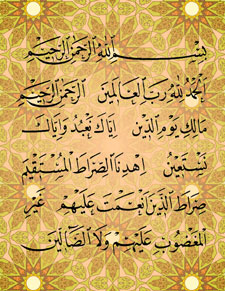
Under Construction.
This section will provide the information regarding
major styles of Islamic Calligraphy, their rules, alphabets, and scripts.
- Thuluth
Thuluth was the medieval Islamic style of handwritten alphabet. Thuluth (Arabic: "one-third") is written on the principle that one-third of each letter slopes. It is a large and elegant, cursive script, used in medieval times on mosque decorations. It took on some of the functions of the early Kufic script; it was used to write surah headings, religious inscriptions, and princely titles and epigraphs. It was also used for many of the large copies of the Koran produced from the 13th century.
- Naskh
Naskh, which means "copying," was developed in the 10th century, and refined into a fine art form in Turkey in the 16th century. Since then it became generally accepted for writing the Quran. Naskh is legible and clear and was adapted as
 the
preferred style for typesetting and printing. It is a small script
whose lines are thin and letter shapes are round.
the
preferred style for typesetting and printing. It is a small script
whose lines are thin and letter shapes are round.
- Riqaa
Riq'a, the simpler style of everyday writing is very economical and easy to write. It is popular for writing both Turkish and Arabic.
- Diwani
The Diwani script is a cursive style of Arabic calligraphy developed during the reign of the early Ottoman Turks (16th-early 17th century). It was invented by Housam Roumi and reached its height of popularity under Süleyman I theMagnificent (1520-66). As decorative as it was communicative, Diwani was distinguished by the complexity of the line within the letter and the close juxtaposition of the letters within the word.
A variation of the Diwani, the Diwani Al Jali, is characterized by its abundance of diactical and ornamental marks.
- Nastaalique

The Ta'liq / Nasta'liq / Farsi Scripts
Ta'liq is a cursive style of lettering developed in Iran in the 10th century. It is thought to have been the creation of Hasan ibn Husain Ali of Fars, but, because Khawaja Abdul Mali Buk made such vast improvements, the invention is often attributed to him. The rounded forms and exaggerated horizontal strokes that characterize the Ta'liq letters were derived primarily from the Riqa' script. The ornateness and sloping quality of the written line had roots in the Towqi script of Ibn Muqla (died 940). Designed specifically to meet the needs of the Persian language, Ta'liq was used widely for royal as well as daily correspondence until the 14th century, when it was replaced by Nasta'liq.
Nasta'liq was the predominant style of Persian calligraphy during the 15th and 16th centuries. The inventor was Mir 'Ali of Tabriz, the most famous calligrapher of the Timurid period (1402-1502). A cursive script, Nasta'liq was a combination of the Naskh and Ta'liq styles, featuring elongated horizontal strokes and exaggerated rounded forms. The diacritical marks were casually placed, and the lines were flowing rather than straight. Nasta'liq was frequently incorporated into the paintings of the early Safavid period (16th century) and is traditionally considered to be the most elegant of the Persian scripts.
Today, there are around 10 styles of this script being practiced world-wide. But the most delicated form of this style is developed in Sub-continent. At the end of 19th century, Persian style was the most popular style of Nasta'liq in india but within next 30 years, there were three new styles evolved from it. First of them is Nasta'liq Lakhnawi (Developed in Lakhnau, India), Second is Dehelwi (Developed in Delhi, India) and third is Nasta'liq Lahori (Developed in Lahore, Pakistan). Dehelvi Nasta'liq was developed by Muhammad Yousuf Dehelwi and Lahori Nastaaliq by Abdul Majeed Parveen Raqam.
- Shikasta
- Taalique
- Riqa
- Kufik
Kufic script, a heavy monumental Arabic script suited to stone carving, appears in the earliest surviving Koran manuscripts. In these, the diacritical marks over the letters are sometimes painted in red, and the gold decorations between suras contrast handsomely with the heavy black script. In the Seljuk period, a more cursive flowing script, Naskhi, developed. The two styles were often used for contrast in architecture and decorative contexts.
- Ijaza
- Rehan
- Zulf-e-Uroos
- Siyaqat
- Muhaqqiq
- Mutaakkis
- Toqiea
Decorative Styles:
- Gulzar
- Ghubar
- Mahi
- Hilal
- Marwareed or Johar
- anjum
- Munaqqash
- Fawakehat
- Afshan
- Saya
- Larza
- Abri
- Manshoor
- Nakhun
- Tughra